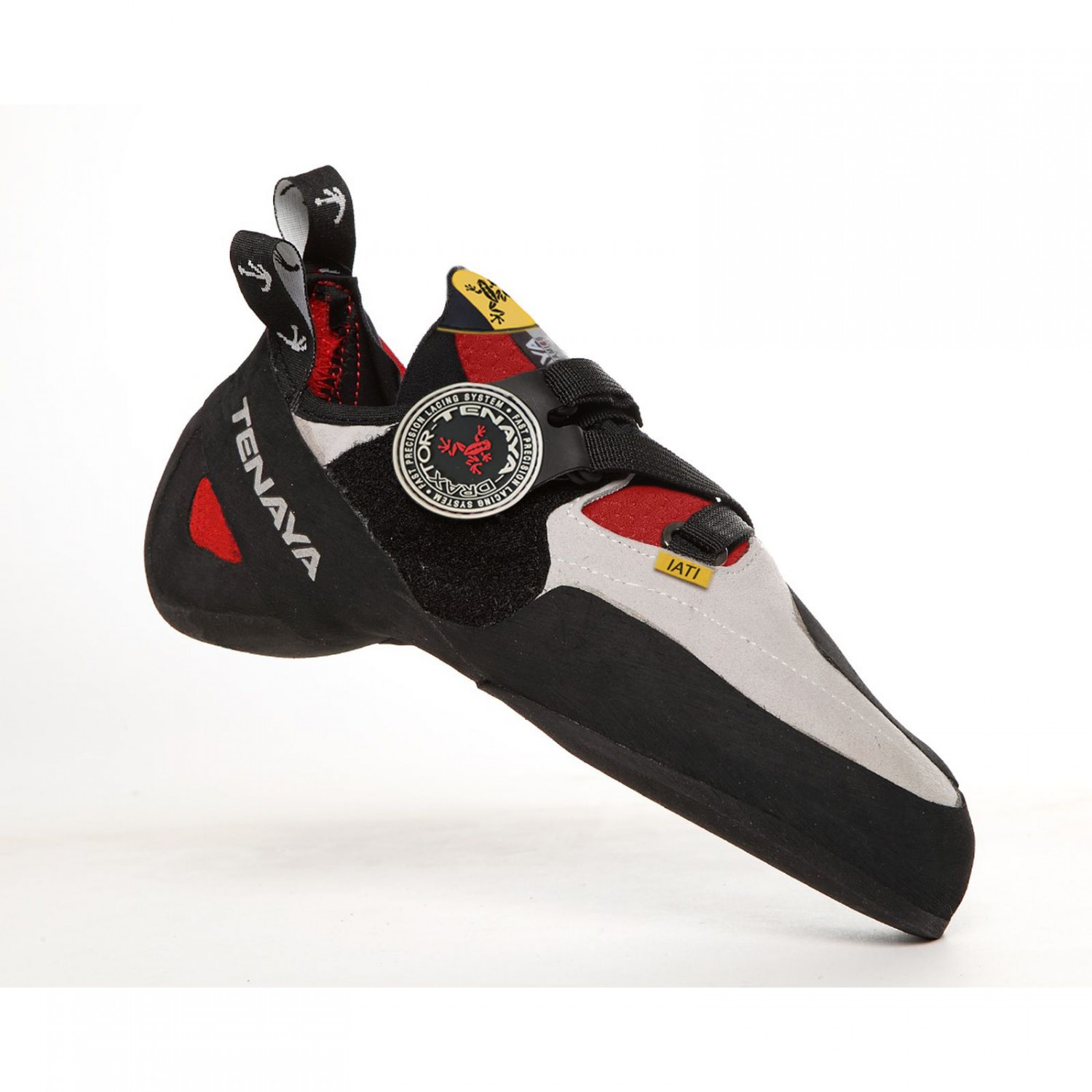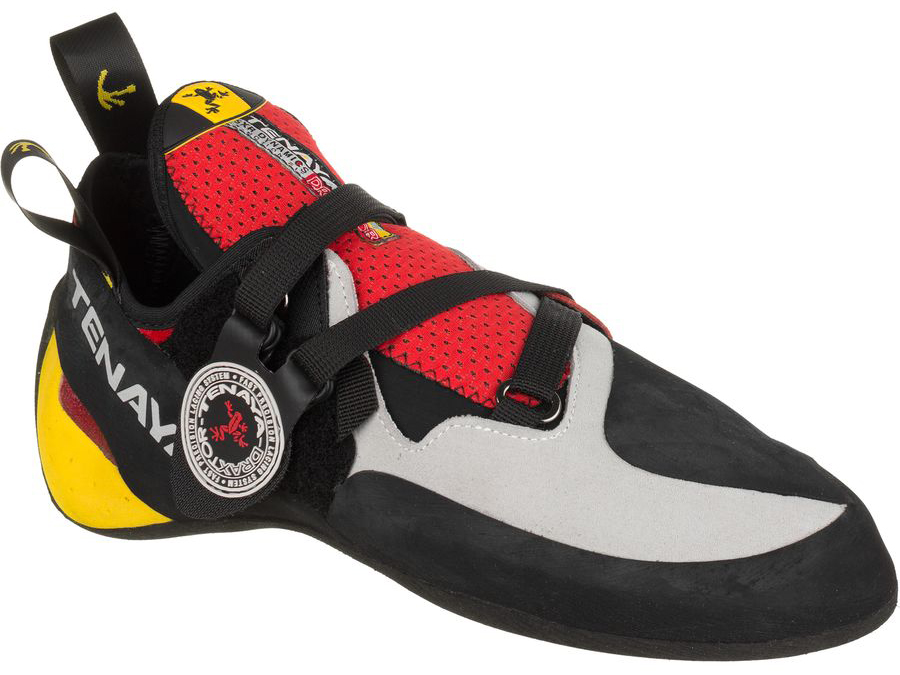
Tenaya IATI
Size Tested: US M’s 7 (EU 39.5)
Available Sizes: US M’s 2-14; US W’s 3-15
Construction
- Upper: Leather microfiber with perforated lycra tongue
- Inner: Cotton with TXT treatment
- Insole: 2D multi-layer stretch tex
- Midsole: Double midsole GI 1.8 + TST 150
- Outsole: Vibram XS Grip 3.5 mm
- Closure: Velcro, Draxtor PAT system
Stated weight per shoe: 340 g; 12.0 oz
MSRP: $170
Days Worn: : ~20 days of bouldering, ~10 days of additional gym use
Test Location: Pawtuckaway, NH; Southern Colorado; Bishop, CA; Hueco Tanks, TX
Tenaya is a Spanish company that has recently been gaining more traction in the United States. With endorsements from the likes of Alex Megos and Ethan Pringle, our interest was piqued, and we decided to check out their latest high-performance shoe, the IATI.
Tenaya markets the IATI as maximizing the connection between climber and rock. It comes packed with a slew of technologies, and Tenaya boasts about the IATI’s responsiveness, performance, and comfort.
Construction / Design
Since the IATI has a slightly less aggressive design than other comparable shoes (e.g., the La Sportiva Solution and Testarossa, or the 5.10 Dragon), I was a bit skeptical as to how the IATI would perform for hard or steep bouldering and sport climbing.
One of the first things I noticed about the IATI was its lack of a significant downturn. While it still has a bit of a downturn, it isn’t nearly as dramatic as some of the P3-equipped La Sportiva shoes.
But Tenaya largely makes up for this lack of downturn with the stiffness of the IATI. With a 3.5 mm Vibram outsole in addition to a double-layer midsole, the IATI is very stiff. I found that this combination of stiffness and only a slight downturn actually made the shoe better equipped than more aggressively downturned shoes to deal with a wide variety of styles.
The other thing that I noticed in terms of the IATI’s construction is that there is a lot of material here. As I already mentioned, there is a lot going on with the sole, which contributes to making it a very stiff shoe. But the rest of the shoe isn’t exactly minimalist, either.
I wasn’t sold initially, but the construction and features of the shoe have grown on me. The inner of the shoe is a cotton material that is given a “TXT treatment,” which essentially just aids in moisture control and comfort. And the tongue is perforated Lycra with a lighter, stretchier material on the sides. So the inner of the shoe is actually really comfortable and breathable once you get into it.
Sizing / Fit
I reviewed a size 39.5 in the IATI, which is the same as my size for most La Sportiva shoes. I was a bit worried when I first got the shoes since they felt relatively comfortable right out of the box, and I assumed that they would stretch a bit and be too big due to the leather microfiber upper. But the IATI stretched a surprisingly small amount, and after a number of days in the shoes, they still fit almost as snugly as they did the first time I put them on.
The IATI has a pretty comfortable and sock-like fit. My only complaint is the heel. It might just be that my heel doesn’t fit the shoe very well, since I love the Solution heel which has a very different construction than the IATI. The IATI feels shallow to me, like my entire foot is locked into the shoe except for my heel. This means that when I’m pulling straight on heel hooks, my heels don’t feel nearly as secure as they do in a Solution. But a lot of people I talk to are not huge fans of the Solution heel since it doesn’t fit them well, so I’m sure the IATI heel will work well for some people.
What I do like about the heel is that there is a slightly softer section of rubber (the yellow rubber) on the outside of the heel. I’ve found this to be great for more friction-dependent heel hooks on slopey features, since it has that little bit of give to it that catches on the tiny features of terrible holds.
Getting Them On
Although the IATIs are comfortable once you’re in them, getting them on can be a bit of an ordeal. The tongue and inner liner are relatively loose inside the shoe. And while this is part of what makes the IATI so comfortable, it can also get in the way when you’re trying to get the shoe on. I found that I usually have to get my foot partway in, then pull the liner up like a sock, since it gets bunched up as your foot goes in. That said, once you get used to this, it isn’t that big of a deal and I think that it is definitely worth the effort given the comfort of the liner.
Closure System
I’m a big fan of the IATI’s. Tenaya calls it their “Draxtor PAT” system, and it’s an adjustable velcro closure system. It is very reminiscent of the Solution closure in that it is made of webbing straps attached to a large velcro patch.
But the straps are adjustable via small “buckles,” so the closure can be changed for feet of slightly different sizes, or for different tightness preferences. The straps also wrap far over the forefoot, creating a more secure feel. In terms of adjustability and security, the closure almost feels like a lace-up shoe, but with the quickness of velcro.

That said, my only complaint is that for the shoes to feel tight and secure enough for my liking, I had to tighten the straps to the point where I can barely squeeze my foot in through them, before I even close the straps with the velcro flap (and I have a pretty standard arch height). And while this may not be the case for everyone using the shoes, it is something to consider if you generally like your shoes to be very tight.
Performance
The IATI performed generally well across the spectrum, but since it lacks the serious downturn of some other comparable shoes, it isn’t the best for super aggressive, overhanging, footwork.
For all the basics—edging, smearing on slab, and moderately overhung climbing—the IATI performed very well. It felt stiff and aggressive, but not overly so when you need a little more sensitivity and balance. And so, in these ways, it is a great all-around shoe.
The only place where it fell short of a shoe like the Solution is when you get into serious steeps. On roofs or steep overhangs, the IATI weren’t quite what I hoped. Part of the problem might have been that the IATI isn’t an ideal fit for my foot, but whenever I was in terrain like this, I found myself wishing I had that extra bit of downturn to really be able to pull into the feet as best as possible.
I also found myself a little less than satisfied with the heel and toe hooking ability of the shoe. While it isn’t terrible, I definitely still feel far more secure doing any kind of toe or heel hooking in the stiffer heel of the Solution. But again, I know lots of people who prefer a softer heel, and maybe you do, too. If that is the case, the IATI heel will probably feel better than something like a Solution, and I think we’re in personal-preference territory here.
What all this amounts to is that I would call the IATI more of a generalist than a specialist. Shoes like the Solution are specialists, in that where they excel is on the steepest of the steep, the most aggressive and technical terrain. This definitely isn’t what I found with the IATI, and if I had to give the most brief summary I could of the shoe, it would be best suited for “all-around high-performance.”
So given that a lot of my climbing revolves around “specialist shoe climbing,” the IATI isn’t going to be my new go-to shoe. But I have found applications where I like the IATI over other shoes, and I’m going to keep it around for longer climbs where I need something that can do a bit of everything.
Bottom Line
While my initial fears about the claimed aggressiveness of the Tenaya IATI were, to some degree, confirmed, I still think that it is a great all-around shoe. The construction of the shoe is high quality, and while it is still on the aggressive end of the spectrum, I think that the IATI is definitely worth checking out for anyone who tends to prefer a high-performance shoe that can still do a bit of everything.
